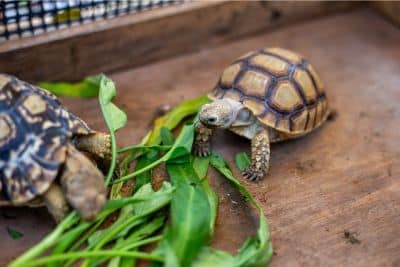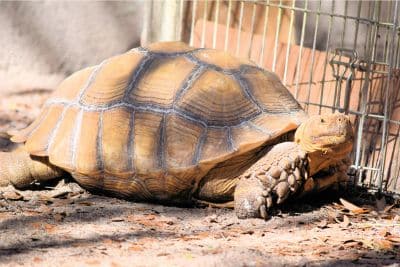Lighting is one of the most confusing aspects of tortoise husbandry for many keepers. And that’s unfortunate, as proper lighting is vital to your tortoise’s long-term health and well-being.
Historically, there weren’t many great options for providing pet tortoises with proper lighting. The only way to provide your tortoise with proper lighting was to house him outdoors. But things have changed over the last several decades, and modern tortoise keepers have several different options for providing proper lighting in indoor enclosures.
In this article, I’ll explain everything you need to know about what constitutes the right type of UVB light for tortoises, so that your pet can live a long, healthy life.
The Electromagnetic Spectrum: Different Kinds of Light
To understand how to provide your tortoise with proper lighting, you first have to learn a little bit about light. Light is a type of electromagnetic radiation that occurs along a spectrum of wavelengths (or frequencies – they’re inversely related).
Humans are most familiar with visible light, which has wavelengths that are in the middle portion of the spectrum, ranging from about 400 to 700 nanometers. The different wavelengths correspond to the different colors we perceive. For example, violet light is about 400 nanometers long, while red light is about 700 nanometers long.
Light outside of this range is invisible to humans, though some animals can perceive light with longer or shorter wavelengths.
Light that has longer wavelengths than visible red light is called infrared light. Infrared light feels warm, and some reptile heating devices produce infrared light to heat up tortoise enclosures. As the wavelengths become longer than infrared rays, the light falls into the microwave category. Even longer wavelengths create radio waves.
At the opposite end of the spectrum, light with wavelengths that are shorter than visible violet light are called ultraviolet. But ultraviolet light is broken up into three categories:
- UVA: UVA light has wavelengths of between 315 and 400 nanometers. This type of light is likely visible to tortoises, and exposure to light of such wavelengths helps tortoises properly recognize food and encourages natural behaviors.
- UVB: Light with wavelengths measuring between 280 and 315 nanometers falls into the UVB portion of the spectrum. Light in this range helps tortoises to produce Vitamin D, which is essential for properly metabolizing dietary calcium. Tortoises deprived of UVB may develop serious illnesses.
- UVC: UVC light is harmful to living organisms. In fact, these wavelengths of light (which are between 100 and 280 nanometers) are used in some cases to kill germs.
In the interest of being comprehensive, light rays with wavelengths that are shorter than ultraviolet light are called X-rays. Even shorter rays fall into the gamma ray category.
The Lighting Needs of Tortoises
As briefly explained above, tortoises need both UVA and UVB lighting. The former helps them to recognize food and exhibit natural behaviors, while the latter helps them produce the vitamin D they need to utilize dietary calcium.
Deprived of UVA, tortoises may become depressed or stop eating. But those who don’t obtain sufficient UVB may develop something called metabolic bone disease (MDB). This can cause the bones and shell to become soft or deformed, along with other symptoms.
Unfortunately, MBD is difficult if not impossible to treat, so prevention is crucial. Accordingly, tortoise keepers should always provide their pets with access to full-spectrum light that includes light in the UVA and UVB portions of the spectrum.
The exact amount of UVA and UVB radiation tortoises need is not well understood. However, species hailing from bright, wide-open habitats near the equator likely need stronger UVA and UVB rays than those who hail from temperate areas or rainforest habitats.
Providing UVB Light for Tortoises
Now that you understand the importance of UVB lighting for your tortoise, I can explain the ways you can provide it to your tortoise. Unfortunately, there are only two viable options:
- Purchase and install UVB-producing lights for your pet’s enclosure. Because most tortoise keepers rear their pets indoors, this is the most popular method for satisfying your pet’s UVB needs. There are at least four different kinds of light bulbs that are capable of producing UVB light, and they all exhibit various benefits and drawbacks.
- Maintain your tortoise outdoors. The sun produces all of the UVB light your pet will need, provided that you live reasonably close to the equator. Those keepers living far from the equator may not receive sunlight with sufficient UVB rays. This is reflected in human healthcare, as people living near the poles must often consume Vitamin D supplements – particularly during the winter.
Some keepers try to maintain their tortoise indoors and simply provide regular “yard time,” during which the animal can absorb UVB rays. This is possible, but rarely recommended – it is simply too time-consuming for most keepers to provide several hours of outside time four or five days per week.
Note that glass filters out UVB rays, so you can’t simply place your pet’s habitat near a window.
The Best UVB Lights for Tortoises
As mentioned, there are several types of UVB-producing lights that you can use in your tortoise’s enclosure. They include:
- Linear Fluorescent Bulbs: Linear fluorescent tubes were the first type of reptile light designed to produce UVB light. They require a special ballast to work, which means that many modern keepers now opt for other styles. It’s also important to note that these bulbs do not produce much heat, so you’ll still need to include an effective heat lamp set-up in your pet’s enclosure.
- Compact Fluorescent Bulbs: Compact fluorescent lights are similar to their linear counterparts, except that they’re smaller and will screw into a typical heat lamp (though they do not produce much heat themselves). Compact fluorescent bulbs are often the most affordable option, and they work well for small enclosures.
- LED Bulbs: LED lights are the newest type of full-spectrum light to arrive on the reptile-keeping market, and they’re quickly drawing the attention of many keepers. While LED light systems can be expensive, they often produce very attractive light, and some systems offer unparalleled lighting control.
- Mercury Vapor Bulbs: Mercury vapor bulbs are likely the preferred option for many keepers, as they produce both full-spectrum light and heat. This means you can satisfy your tortoise’s need for heat and UVB light with one device. However, some mercury vapor bulbs are expensive and some produce too much heat for small enclosures.
Tips for Setting Up UVB Lights for Your Tortoise
Setting up your tortoise’s UVB lights is not as simple as just tossing a fixture on top of the enclosure. There are a few important things you’ll want to keep in mind:
- Always ensure that your pet has access to an area that’s shaded from the UVB bulbs. It is thought that most reptiles can regulate their Vitamin D production by altering the amount of time they expose themselves to light. So, be sure that your pet has at least one (and preferably several) places he can access that’ll allow him to avoid the light.
- Be sure that the bulbs are relatively close to your pet. UVB light rays become weaker with increasing distance from the source. So, you’ll need to be sure the light fixtures are within about 12 inches of the top of your tortoise’s shell.
- Place the UVB lights over the basking spot, near the heat lamp. You’ll want to cluster the UVB lights and heat lamps in one place over the enclosure. This will provide the most realistic basking spot for your pet.
- Replace the UVB bulbs regularly. UVB lights do not continue producing UVB rays forever. In fact, the amount of UVB radiation produced will steadily decrease over time, despite the fact that the light will continue producing visible light. Check the manufacturer’s recommendation, but most UVB lights should be replaced every 6 to 12 months.
- Connect the UVB bulbs to a timer. It is important to provide your pet with a consistent day-night cycle that mimics the photoperiod he’d experience in the wild. So, purchase and use a lamp timer to automate the process.
It’s also important that you use UVB lights safely. You don’t want to look directly at these lights yourself, so it is generally wise to include some type of barrier that is located between the lamp and the place you’ll usually observe the habitat from.
Citations
- Tortoise Trust – Understanding Reptile Lighting Systems
- UCAR Center for Science Education – The Electromagnetic Spectrum
- Packerland Vet – Metabolic Bone Disease


